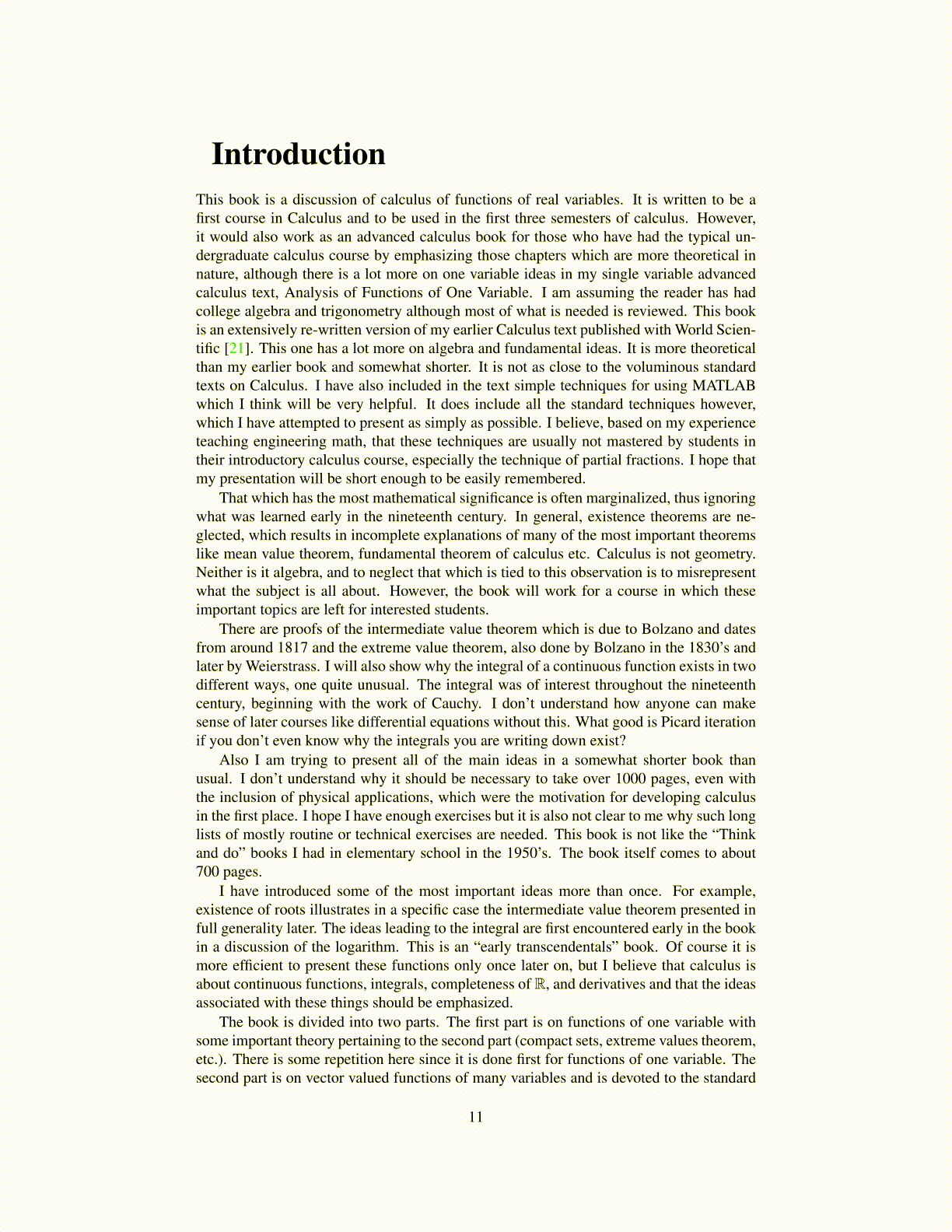
IntroductionThis book is a discussion of calculus of functions of real variables. It is written to be afirst course in Calculus and to be used in the first three semesters of calculus. However,it would also work as an advanced calculus book for those who have had the typical un-dergraduate calculus course by emphasizing those chapters which are more theoretical innature, although there is a lot more on one variable ideas in my single variable advancedcalculus text, Analysis of Functions of One Variable. I am assuming the reader has hadcollege algebra and trigonometry although most of what is needed is reviewed. This bookis an extensively re-written version of my earlier Calculus text published with World Scien-tific [21]. This one has a lot more on algebra and fundamental ideas. It is more theoreticalthan my earlier book and somewhat shorter. It is not as close to the voluminous standardtexts on Calculus. I have also included in the text simple techniques for using MATLABwhich I think will be very helpful. It does include all the standard techniques however,which I have attempted to present as simply as possible. I believe, based on my experienceteaching engineering math, that these techniques are usually not mastered by students intheir introductory calculus course, especially the technique of partial fractions. I hope thatmy presentation will be short enough to be easily remembered.
That which has the most mathematical significance is often marginalized, thus ignoringwhat was learned early in the nineteenth century. In general, existence theorems are ne-glected, which results in incomplete explanations of many of the most important theoremslike mean value theorem, fundamental theorem of calculus etc. Calculus is not geometry.Neither is it algebra, and to neglect that which is tied to this observation is to misrepresentwhat the subject is all about. However, the book will work for a course in which theseimportant topics are left for interested students.
There are proofs of the intermediate value theorem which is due to Bolzano and datesfrom around 1817 and the extreme value theorem, also done by Bolzano in the 1830’s andlater by Weierstrass. I will also show why the integral of a continuous function exists in twodifferent ways, one quite unusual. The integral was of interest throughout the nineteenthcentury, beginning with the work of Cauchy. I don’t understand how anyone can makesense of later courses like differential equations without this. What good is Picard iterationif you don’t even know why the integrals you are writing down exist?
Also I am trying to present all of the main ideas in a somewhat shorter book thanusual. I don’t understand why it should be necessary to take over 1000 pages, even withthe inclusion of physical applications, which were the motivation for developing calculusin the first place. I hope I have enough exercises but it is also not clear to me why such longlists of mostly routine or technical exercises are needed. This book is not like the “Thinkand do” books I had in elementary school in the 1950’s. The book itself comes to about700 pages.
I have introduced some of the most important ideas more than once. For example,existence of roots illustrates in a specific case the intermediate value theorem presented infull generality later. The ideas leading to the integral are first encountered early in the bookin a discussion of the logarithm. This is an “early transcendentals” book. Of course it ismore efficient to present these functions only once later on, but I believe that calculus isabout continuous functions, integrals, completeness of R, and derivatives and that the ideasassociated with these things should be emphasized.
The book is divided into two parts. The first part is on functions of one variable withsome important theory pertaining to the second part (compact sets, extreme values theorem,etc.). There is some repetition here since it is done first for functions of one variable. Thesecond part is on vector valued functions of many variables and is devoted to the standard
11